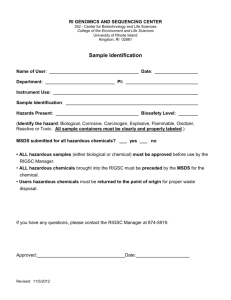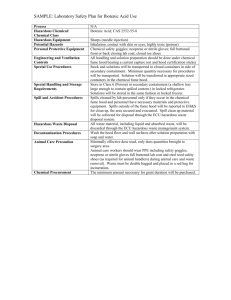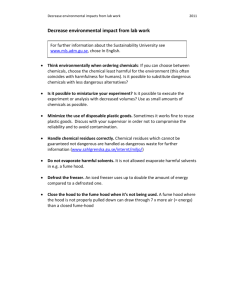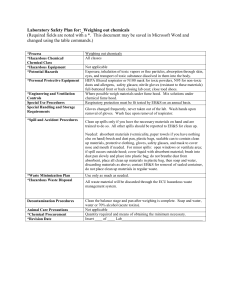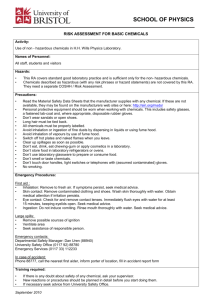Standard Operating Procedure Page 1
advertisement
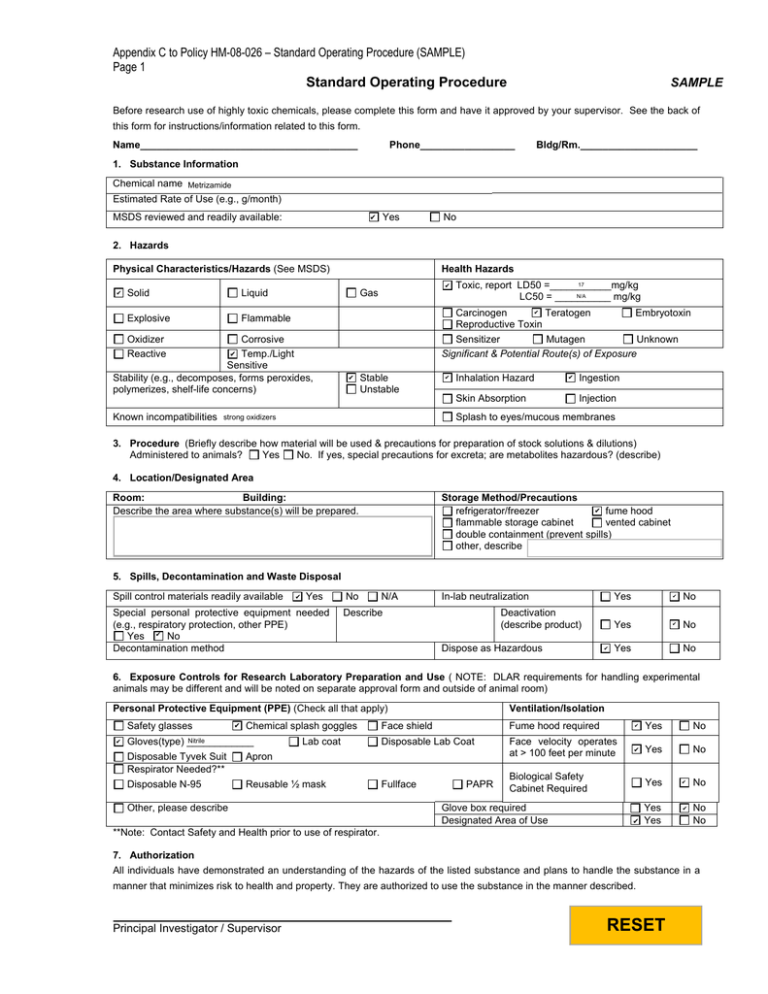
Appendix C to Policy HM-08-026 – Standard Operating Procedure (SAMPLE) Page 1 Standard Operating Procedure SAMPLE Before research use of highly toxic chemicals, please complete this form and have it approved by your supervisor. See the back of this form for instructions/information related to this form. Name_______________________________________ Phone_________________ Bldg/Rm._____________________ 1. Substance Information Chemical name Metrizamide Estimated Rate of Use (e.g., g/month) MSDS reviewed and readily available: ✔ Yes No 2. Hazards Physical Characteristics/Hazards (See MSDS) Health Hazards ✔ ✔ Solid Liquid Explosive Flammable Oxidizer Reactive Gas Corrosive Temp./Light Sensitive Stability (e.g., decomposes, forms peroxides, polymerizes, shelf-life concerns) 17 Toxic, report LD50 =___________mg/kg N/A LC50 = __________ mg/kg ✔ Teratogen Carcinogen Embryotoxin Reproductive Toxin Sensitizer Mutagen Unknown Significant & Potential Route(s) of Exposure ✔ ✔ Stable Unstable ✔ Inhalation Hazard Skin Absorption Known incompatibilities ✔ Ingestion Injection Splash to eyes/mucous membranes strong oxidizers 3. Procedure (Briefly describe how material will be used & precautions for preparation of stock solutions & dilutions) Administered to animals? Yes No. If yes, special precautions for excreta; are metabolites hazardous? (describe) 4. Location/Designated Area Room: Building: Describe the area where substance(s) will be prepared. Storage Method/Precautions ✔ fume hood refrigerator/freezer flammable storage cabinet vented cabinet double containment (prevent spills) other, describe 5. Spills, Decontamination and Waste Disposal Spill control materials readily available ✔ Yes Special personal protective equipment needed (e.g., respiratory protection, other PPE) Yes ✔ No Decontamination method No N/A In-lab neutralization Describe Deactivation (describe product) Dispose as Hazardous ✔ Yes ✔ No Yes ✔ No Yes No 6. Exposure Controls for Research Laboratory Preparation and Use ( NOTE: DLAR requirements for handling experimental animals may be different and will be noted on separate approval form and outside of animal room) Personal Protective Equipment (PPE) (Check all that apply) Safety glasses ✔ ✔ Chemical splash goggles Nitrile Gloves(type) ____________ Lab coat Disposable Tyvek Suit Respirator Needed?** Apron Disposable N-95 Reusable ½ mask Other, please describe Ventilation/Isolation Face shield Fume hood required ✔ Yes No Disposable Lab Coat Face velocity operates at > 100 feet per minute ✔ Yes No Fullface PAPR Biological Safety Cabinet Required Glove box required Designated Area of Use ✔ Yes ✔ No Yes Yes ✔ No No **Note: Contact Safety and Health prior to use of respirator. 7. Authorization All individuals have demonstrated an understanding of the hazards of the listed substance and plans to handle the substance in a manner that minimizes risk to health and property. They are authorized to use the substance in the manner described. Principal Investigator / Supervisor RESET Appendix C to Policy HM-08-026 – Standard Operating Procedure (SAMPLE) Page 2 Using This Form For purposes of this form, a highly toxic chemical includes select carcinogens, reproductive toxins, and substances with a high degree of acute toxicity. A more complete definition is included in the Institutional Chemical Hygiene Plan. Each researcher planning to use a toxic chemical must complete this form and have it approved by their Principal Investigator or supervisor and Chemical Hygiene Officer/Safety and Health prior to their initial use. Responsibility for determining whether a chemical is a toxic chemical and completing this form rests jointly with the supervisor, principle investigator and individual seeking approval. Substance Information Carcinogen: if on IARC, OSHA or NTP list. Reproductive toxin: mutagens, teratogens, embryotoxins. High Acute Toxicity: oral LD50 < 50 mg/kg, skin LD50 < 200 mg, air LC50 < 200 ppm or < 2 mg/l. MSDS may be available in hard copy or via the internet. Hazards (Refer to Physical Properties section of MSDS) Flammable liquid: flashpoint = 100° F. Flammable solid: liable to cause fire through friction, absorption of moisture, spontaneous chemical change, or which can be ignited readily and when ignited burns vigorously Corrosive: Causes visible destruction of, or irreversible alterations in, living tissue by chemical action at the site of contact. Reactive: May become unstable or contact with water produces flammable or toxic gas. Temperature Sensitive: Must be kept within a certain temperature range to ensure stability. Unstable: substance will vigorously polymerize, decompose, condense, or will become self-reactive under conditions of shock, or high or elevated pressure or temperature. Also includes time-sensitive materials, particularly those that produce peroxides over time. Incompatibilities: list chemicals or materials that might cause instability or adverse conditions if mixed with the particularly hazardous substance(s). Inhalation: inhalation of the substance may cause adverse health effects. Skin exposure: substance is readily absorbed through the skin or can cause significant damage to skin upon contact. Sensitizer: certain chemicals are known to effect the immune system, causing a person to experience allergic reactions, up to and including anaphylactic shock, upon exposure to the chemical, after the initial sensitization. Some chemicals can accumulate in body tissues and may require initial or periodic medical surveillance. Contact Safety and Health or for more information. Procedure Briefly describe the part of the experimental procedure that involves the substance, with particular attention to how the chemical will be manipulated. Vacuum systems include central vacuum systems and vacuum pumps within the lab. Describe what will be done to ensure that the substance is not accidentally drawn into the vacuum system. Cold traps or filters are some examples of such measures. Toxic chemicals administered to animals may pose a hazard to animal handlers via contact with excreta and metabolites. Separate Hazard Controls will be designated on another sheet and on the door to your animal room. You are required to comply with all posted Personal Protective Equipment Signage and recommendations. Location/Designated Area Building and room number where the substance will be used. Describe where in this room the substance will be used. For example, in a hood, on a specific benchtop, in several areas of the laboratory, etc. This room or area must be posted with a Designated Area sticker. Describe where the substance will be stored. Be specific, e.g., on a shelf, in a refrigerator, in a hood, etc. Double containment means that the container will be placed inside another container that is capable of holding the contents in the event of a leak and provides a protective outer covering in the event of contamination of the primary container. Spills, Decontamination and Waste Disposal Describe how the work area will be decontaminated after use, in the event of a spill, or upon completion of the work and before removal of the designated area signage. Some corrosive chemicals may be neutralized before disposal via the drain or the hazardous waste program. Some materials, such as ethidium bromide, can be chemically deactivated before disposal via the drain or the hazardous waste program. Contact Safety and Health for more information about the hazardous waste program. Toxic chemicals must not be poured down the drain without consulting Safety. Appendix C to Policy HM-08-026 – Standard Operating Procedure (SAMPLE) Page 3 Exposure Controls Safety glasses protect from flying particles and minor chemical splashes, for instance, from opening a centrifuge tube. Chemical splash goggles should be worn when there is a possibility of a significant chemical splash. Most chemical manipulations, particularly where pressure is involved, warrant chemical splash goggles. Face shield, worn with splash goggles, provides full face protection when working with large volumes of chemicals or exposure to UV light. Gloves should be worn when working with any particularly hazardous substance. Since not all gloves offer significant protection from every chemical, it is important to choose the glove that offers the best resistance. See the MSDS, glove manufacturer compatibility charts, or contact Safety and Health for more information. Lab coats should be worn when working with hazardous substances. The coat should not be worn outside the laboratory and should be laundered separately from other clothing. Aprons offer chemical resistance and protection from splashes and can be used in conjunction with a lab coat. Respirators offer protection from inhalation of substances when engineering controls are not sufficient. However, use of respirators must be approved by Safety. Contact Safety and Health if you believe a respirator is needed. Self-Contained Breathing Apparatus (SCBA) users must be approved by Safety and must attend training at least annually. Contact Safety and Health for more information. A fume hood should be used for chemicals that may produce vapors, mists, or fumes, or if the procedure may cause generation of aerosols. The hood must have an average face velocity of between 80 and 120 feet per minute. This measurement is noted on the hood survey sticker. If the hood has not been inspected within the past year, contact Safety and Health for re-inspection before using the hood. A glove box should be used if protection from atmospheric moisture or oxygen is needed or when a fume hood may not provide adequate protection from exposure to the substance; e.g., a protection factor of 10,000 or more is needed. Highly toxic gases must be used and stored in a vented gas cabinet connected to a laboratory exhaust system. Gas feed lines operating above atmospheric pressure must use coaxial tubing. For help in determining whether a substance meets the toxic chemical criteria, call Safety & Health at X5069 on the Health Science Campus and X3600 on the Main Campus. Revised: 12/13/06 2/1/10 6/28/10 2/1/11
